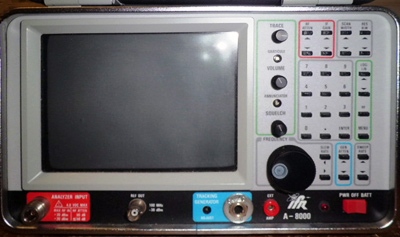
|
|
The Aeroflex-IFR A-8000 2.6 GHz Spectrum Analyzer is a wide band, very sensitive receiver. It works on the principle of "super-heterodyne receiver" to convert higher frequencies (normally ranging up to several 10s of GHz) to measurable quantities. The received frequency spectrum is slowly swept through a range of pre-selected frequencies, converting the selected frequency to a measurable DC level (usually logarithmic scale), and displaying the same on the CRT of the IFR A-8000. The CRT displays received signal strength (y-axis) against frequency ( x-axis). Applications for IFR A-8000 Spectrum Analyzer includes Site Monitoring: Verify that the frequency and signal strength of your transmitter is accurate. Interference: Before a system is installed you use a A-8000 spectrum analyzer to verify that the frequencies (you plan to use) are not occupied or if the presence of a very strong signal will interfere with your new setup. Interference can be created by a number of different situations. Other tests that utilize the IFR A-8000 spectrum analyzer features include antenna isolation, co-channel interference, adjacent channel power, occupied bandwidth, intermodulation, microwave or satellite antenna alignment, and characterization of components. Specifications. Frequency Range: 10 kHz to 2.6 GHz. Frequency Accuracy: 0.0005%. Minimum Span: 1 kHz. Maximum Span: 250 MHz. Minimum Sweep Time: 5 ms. Maximum Sweep Time: 10s. Minimum Resolution Bandwidth: 300 Hz. Maximum Resolution Bandwidth: 3 MHz. Resolution Bandwidth Steps: 1/10/100. Minimum Single-Side-Band Noise: 65 dBc/Hz. Maximum Safe AC Input: 30 dBm. Maximum DC Input: 4 V. Maximum Dynamic Range: 70 dB.
|